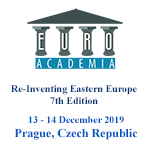Euroacademia Conferences
 Europe Inside-Out: Europe and Europeanness Exposed to Plural Observers (9th Edition) April 24 - 25, 2020
Europe Inside-Out: Europe and Europeanness Exposed to Plural Observers (9th Edition) April 24 - 25, 2020 Identities and Identifications: Politicized Uses of Collective Identities (9th Edition) June 12 - 13, 2020
Identities and Identifications: Politicized Uses of Collective Identities (9th Edition) June 12 - 13, 2020 8th Forum of Critical Studies: Asking Big Questions Again January 24 - 25, 2020
8th Forum of Critical Studies: Asking Big Questions Again January 24 - 25, 2020 Re-Inventing Eastern Europe (7th Edition) December 13 - 14, 2019
Re-Inventing Eastern Europe (7th Edition) December 13 - 14, 2019 The European Union and the Politicization of Europe (8th Edition) October 25 - 26, 2019
The European Union and the Politicization of Europe (8th Edition) October 25 - 26, 2019 Identities and Identifications: Politicized Uses of Collective Identities (8th Edition) June 28 - 29, 2019
Identities and Identifications: Politicized Uses of Collective Identities (8th Edition) June 28 - 29, 2019 The European Union and the Politicization of Europe (7th Edition) January 25 - 26, 2019
The European Union and the Politicization of Europe (7th Edition) January 25 - 26, 2019 7th Forum of Critical Studies: Asking Big Questions Again November 23 - 24, 2018
7th Forum of Critical Studies: Asking Big Questions Again November 23 - 24, 2018 Europe Inside-Out: Europe and Europeanness Exposed to Plural Observers (8th Edition) September 28 - 30, 2018
Europe Inside-Out: Europe and Europeanness Exposed to Plural Observers (8th Edition) September 28 - 30, 2018 Identities and Identifications: Politicized Uses of Collective Identities (7th Edition) June 14 - 15, 2018
Identities and Identifications: Politicized Uses of Collective Identities (7th Edition) June 14 - 15, 2018
Tivat’s Trajectory – From Arsenal to Porto Montenegro
-
-

-
Presentation speakers
- Ksenija Martinovic, Central European Initiative, Trieste, Italy
- Download presentation
Abstract:
This paper examines how and to what extent urban regeneration works in practice through the lens of Tivat’s regeneration. The paper enlightens Tivat’s economic and physical transformation from the town know as a base of the Naval-shipyard “Arsenal” to the nautical-touristic complex “Porto Montenegro”. In the modern history urban development of Tivat was related to the Naval-shipyard “Sava Kovacevic”, most often referred to by its old name “Arsenal”. Since its development in 1889, Arsenal became the main employer in town and shaped the town’s identity. Arsenal employed experienced skilled workers, mostly engineers and craftsmen, and enjoyed an international reputation for a quality ship repair (Radovic, 2015). In 1990’s, the turbulent political and economic situation in ex-Yugoslavia countries and UN sanctions resulted with the downfall of Arsenal and decline of Tivat’s economy. At the same time, Montenegro decided to make a strategic turnover from a socialist centrally planned to an open market economy. Montenegro wanted to attract inward investments and create an image of an attractive tourist destination that would result with economic revitalisation. These circumstances led to the decision made by the Montenegrin government to sell Arsenal to a private investor who showed the initiative to transform it and create the nautical resort “Porto Montenegro”. Regeneration of Tivat, in terms of its vision, seems to be a successful story – the town’s image was changed, Arsenal’s site became an accessible place and new economic opportunities were made. However, this regeneration did not went without consequences.
-
Related Presentations

Economic Convergence in Central and Eastern Europe
- Andrei Radulescu

Approximation of the Legislation of Member States to EU Tax Policy: The Case Study of Estonia
- Mariam Jikia
- Irakli Gabisonia













